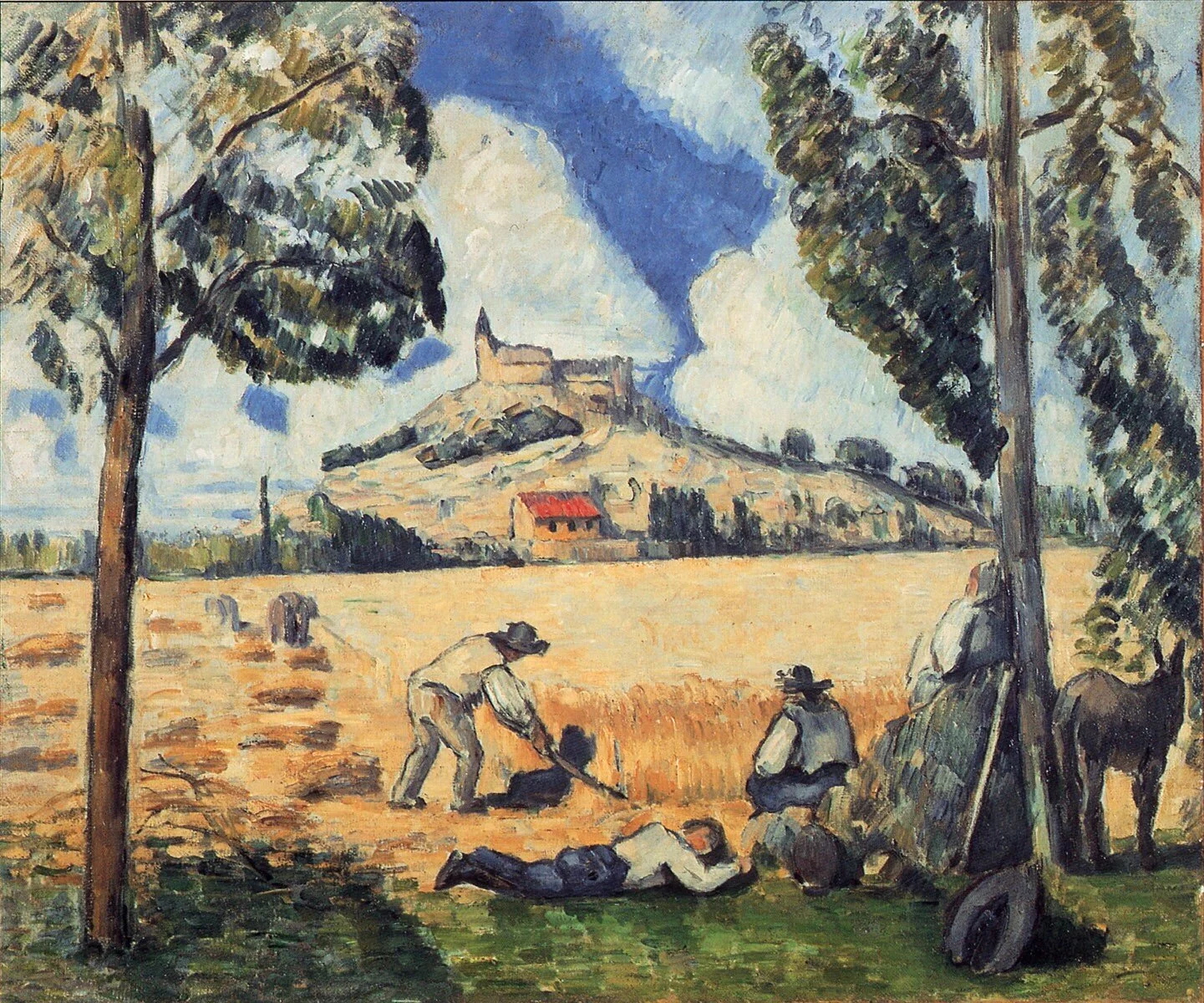The Harvest FWN 651 1877 45.7cm x 55.2
In 1791, a law was passed, the “Chapelier law”, which forbad workers’ associations, including co-operatives and trade unions. During the revolutionary period in France, from 1848 and with the Commune in 1871 onwards, many co-operatives formed clandestinely. The state actively sought out these co-operatives; once found, they were destroyed ruthlessly by the police. On the 27th December 1873, Monet, Renoir, Pissarro, Sisley, Cezanne, Morisot and Degas, with several other artists founded the “Cooperative and Anonymous Association of Painters, Sculptors, and Engravers". You can guess why they wanted to maintain some anonymity. It was not until 1878, that the new Republic repealed the Chapelier law and stopped the police from conducting the attacks.
This painting at first glance seems a gentle countryside scene, and it’s pleasant. I like the colours; there’s a certain balance to it with the trees one on each side, and the hill in the middle ground between the trees. Some commentators want to date it later because of the hashed brush-strokes, but hey, life is a developing kind of thing.
But yes, there is more to this painting than meets the eye!
It’s Cezanne’s version of one of the four seasons painted by Poussin from 1660 called “Summer”; Poussin depicts the Biblical scene, with corn fields, mountain and hill castle in the background, when the rich landowner, Boaz, meets the widowed Ruth, while the workers go about reaping the harvest. Boaz and Ruth go on to marry, and their great grandson is King David – a pretty impressive painting of the simple beginning to a legendary story. Cezanne swaps the white and brown stallions in Poussin’s painting for a donkey; he has the noble Boaz as the boy asleep on the floor; and swaps Ruth in her flowing blue dress as she beseeches Boaz with a peasant woman leaning against a tree with her back to us; and the distant mountain and hillside fortification becomes a Provencal hill village. It’s not that Cezanne wanted to belittle Poussin’s painting: Cezanne was a great admirer of Poussin’s paintings and technique, but he wanted to “bring Poussin back to life, by way of nature”.
Cezanne’s painting was bought by Gauguin, who loved it! He copied it onto a fan, and engraved it into a ceramic vase. When he left for Martinique, he left the painting with a guy called Portier, who lived in the same house as the Van Gogh brothers. Van Gogh later wrote to his brother: “instinctively these days, I keep remembering what I have seen of Cezanne’s work, because he rendered so forcibly, as in the Harvest that we saw at Portier’s, the harsh side of Provence”. The Van Gogh’s knew Provence well, having spent some time in Arles; and maybe Cezanne’s painting expressed a rather forlorn countryside scene - Van Gogh painted his own harvest in Provence in 1888.
After the revolution of 1871, the laws of the new Republic needed changing and modernizing to align with a Republic rather than an Empire. So the Viscount de Tocqueville, one Alexis Charles-Henri-Maurice Clérel de Tocqueville – yea, impressive name – was given the task of going to have a look at what was happening elsewhere in the world. His book “Democracy in America” is a classic, and is one of the founding works of the Social Sciences. As Tocqueville understood it, this rapidly democratizing society had a population devoted to "middling" values which wanted to amass vast fortunes through hard work. In Tocqueville's mind, this explained why the United States was so different from Europe. In Europe, he claimed, nobody cared about making money. The lower classes had no hope of gaining more than minimal wealth while the upper classes found it crass, vulgar and unbecoming of their sort to care about something as unseemly as money. At the same time in the United States, workers would see people fashioned in exquisite attire and merely proclaim that through hard work they too would soon possess the fortune necessary to enjoy such luxuries.
Such values about hard work are more and more threatened by the rise in inequality between the rich and the rest of us. There is much evidence these days, through the social sciences, that the greater the scale of inequality, the more divisive will a society become. Inequality itself does not seem to be the problem, but an extreme scale of inequality certainly is. The French economist Thomas Piketty presented a simple explanation for rising inequality. He argued that wealth generally grows faster than the economy, and it tended to become concentrated, as more wealth brings more opportunities to save and invest.
The early co-operative movement sought to be a vision of a "New World Order" of mutual help, social equality and brotherhood. It developed eight principles, which still hold true today:
Co-operatives are open to everyone
Co-operatives are run by their members
Co-operatives make economic decisions together
Co-operatives are independent
Co-operatives provide education and training
Co-operatives co-operate
Co-operatives support their local communities
Members help decide how profits are allocated. Suggestions might include using profits to develop the co-operative, to build up reserves, to reward members in proportion to their trade with the co-operative, or to support other activities approved by members (such as ethical projects).
The Impressionists certainly sought to situate themselves in the wind of change blowing throughout the world in the middle of the 19th Century.
“You may depend upon it that
there are as good hearts to serve communities
in cottages as in palaces.”
Robert Owen
(amended)
